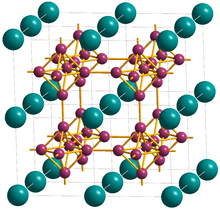Samarium hexaboride
Samarium hexaboride (SmB6) is an intermediate-valence compound where samarium is present both as Sm2+ and Sm3+ ions at the ratio 3:7.[2] It belongs to a class of Kondo insulators.
 | |
| Identifiers | |
|---|---|
| ECHA InfoCard | 100.031.384 |
| Properties | |
| B6Sm | |
| Molar mass | 215.22 g·mol−1 |
| Melting point | 2400 °C ±100[1] |
Except where otherwise noted, data are given for materials in their standard state (at 25 °C [77 °F], 100 kPa). | |
| Infobox references | |
At temperatures above 50 K its properties are typical of a Kondo metal, with metallic electrical conductivity characterized by strong electron scattering, whereas at low temperatures, it behaves as a non-magnetic insulator with a narrow band gap of about 4–14 meV.[3]
The cooling-induced metal-insulator transition in SmB6 is accompanied by a sharp increase in thermal conductivity, peaking at about 15 K. The reason for this increase is that electrons do not contribute to thermal conductivity at low temperatures, which is instead dominated by phonons. The decrease in electron concentration reduced the rate of electron-phonon scattering.[4]
Some research claims that it may be a topological insulator.[5][6][7] Other researchers found no evidence of topological surface states.[8]
The increasing electrical resistance with a reduction in temperature indicates that the material behaves as an insulator; however, recent measurements reveal a Fermi surface (an abstract boundary of electrons in momentum space) characteristic of a good metal, indicating a more exotic dual metal-insulating ground state[9][10]. The electrical resistivity at temperatures below 4K displays a distinct plateau,[11] which is thought to be the coexistence of an insulating state (bulk) and a conducting state (surface). At temperatures approaching absolute zero, the quantum oscillations of the material grow as the temperature declines, a behavior that contradicts both the Fermi analysis and the rules that govern conventional metals.[9][12][10] While it has been argued that quantum oscillations on samples grown from aluminium flux[13] may arise from aluminum inclusions[14], such an explanation is excluded for samples grown by the image furnace method[9][11] rather than by the flux growth method[13][14].
See also
References
- Plenum Press Handbooks of High-Temperature Materials: No. 1 Materials Index p42
- Nickerson, J.; White, R.; Lee, K.; Bachmann, R.; Geballe, T.; Hull, G. (1971). "Physical Properties of SmB6". Physical Review B. 3 (6): 2030. Bibcode:1971PhRvB...3.2030N. doi:10.1103/PhysRevB.3.2030.
- Nyhus, P.; Cooper, S.; Fisk, Z.; Sarrao, J. (1995). "Light scattering from gap excitations and bound states in SmB6". Physical Review B. 52 (20): 14308–14311. Bibcode:1995PhRvB..5214308N. doi:10.1103/PhysRevB.52.R14308. PMID 9980746.
- Sera, M.; Kobayashi, S.; Hiroi, M.; Kobayashi, N.; Kunii, S. (1996). "Thermal conductivity of RB6 (R=Ce, Pr, Nd, Sm, Gd) single crystals". Physical Review B. 54 (8): R5207–R5210. Bibcode:1996PhRvB..54.5207S. doi:10.1103/PhysRevB.54.R5207. PMID 9986570.
- Botimer, J.; Kim; Thomas; Grant; Fisk; Jing Xia (2013). "Robust Surface Hall Effect and Nonlocal Transport in SmB6: Indication for an Ideal Topological Insulator". Scientific Reports. 3: 3150. arXiv:1211.6769. Bibcode:2013NatSR...3E3150K. doi:10.1038/srep03150. PMC 3818682. PMID 24193196.
- Xiaohang Zhang; N. P. Butch; P. Syers; S. Ziemak; Richard L. Greene; Johnpierre Paglione (2013). "Hybridization, Inter-Ion Correlation, and Surface States in the Kondo Insulator SmB6". Phys. Rev. X. 3 (1): 011011. arXiv:1211.5532. Bibcode:2013PhRvX...3a1011Z. doi:10.1103/PhysRevX.3.011011.
- Wolgast; Cagliyan Kurdak; Kai Sun; Allen; Dae-Jeong Kim; Zachary Fisk (2012). "Discovery of the First Topological Kondo Insulator: Samarium Hexaboride". Physical Review B. 88 (18): 180405. arXiv:1211.5104. Bibcode:2013PhRvB..88r0405W. doi:10.1103/PhysRevB.88.180405.
- Hlawenka; Siemensmeyer; Weschke; Varykhalov; Sánchez-Barriga; Shitsevalova; Dukhnenko; Filipov; Gabáni; Flachbart; Rader; Rienks (2018). "Samarium hexaboride is a trivial surface conductor". Nature Communications. 9: 1–7. arXiv:1502.01542. Bibcode:2018NatCo...9..517H. doi:10.1038/s41467-018-02908-7. PMID 29410418.
- B. S. Tan; Y.-T. Hsu; B. Zeng; M. Ciomaga Hatnean; N. Harrison; Z. Zhu; M. Hartstein; M. Kiourlappou; A. Srivastava; M. D. Johannes; T. P. Murphy; J.-H. Park; L. Balicas; G. G. Lonzarich; G. Balakrishnan; Suchitra Sebastian (2015). "Unconventional Fermi surface in an insulating state". Science. 349 (6245): 287–290. arXiv:1507.01129. Bibcode:2015Sci...349..287T. doi:10.1126/science.aaa7974. PMID 26138105.
- Natalie Wolchover (2 July 2015). "Paradoxical Crystal Baffles Physicists". Quanta Magazine. Retrieved 2020-01-15.
- M. Ciomaga Hatnean; M. R. Lees; D. Mck. Paul; G. Balakrishnan (2013). "Large, high quality single-crystals of the new Topological Kondo Insulator, SmB6". Nature. 3 (3071): 3071. Bibcode:2013NatSR...3E3071H. doi:10.1038/srep03071. PMC 3810659. PMID 24166216.
- Borghino, Dario (July 7, 2015). "Puzzling material acts as conductor and insulator at the same time". www.gizmag.com. Retrieved 2015-07-08.
- Li, G.; Xiang, Z.; Yu, F.; Asaba, T.; Lawson, B.; Cai, P.; Tinsman, C.; Berkley, A.; Wolgast, S. (2014-12-05). "Two-dimensional Fermi surfaces in Kondo insulator SmB6". Science. 346 (6214): 1208–1212. arXiv:1306.5221. doi:10.1126/science.1250366. ISSN 0036-8075. PMID 25477456.
- S. M. Thomas; Xiaxin Ding; F. Ronning; V. Zapf; J. D. Thompson; Z. Fisk; J. Xia; P. F. S. Rosa (2019). "Quantum oscillations in flux-grown SmB6 with embedded aluminum". Physical Review Letters. 122 (16): 166401. arXiv:1806.00117. Bibcode:2019PhRvL.122p6401T. doi:10.1103/PhysRevLett.122.166401. PMID 31075018.